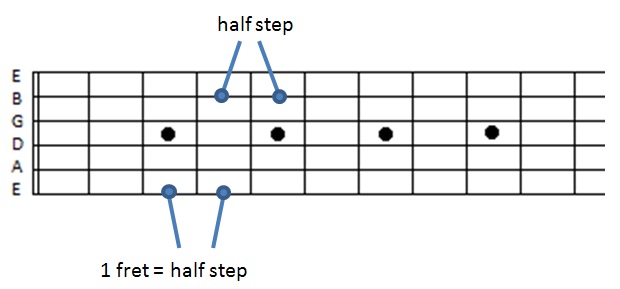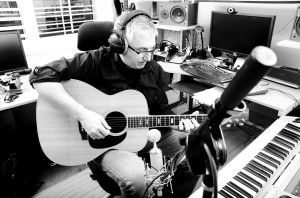 This is my second article in a series covering some basic concepts of music theory, concentrating on topics relating to musical harmony. In this article I’ll be covering the concept of Intervals. It’s important to learn about intervals since they are the most basic building block of harmony.
This is my second article in a series covering some basic concepts of music theory, concentrating on topics relating to musical harmony. In this article I’ll be covering the concept of Intervals. It’s important to learn about intervals since they are the most basic building block of harmony.
The term “interval” is used to describe the pitch distance between two musical notes, whether those notes are played together or consecutively. When someone says “interval” think of it as another word for “musical distance”. In this article I’ll be explaining the names of these distances and also providing many examples of how these musical “distances” are used in music.
Musical distances are often described in terms of a unit called “steps”. First, I will define what is meant by a “step” as it pertains to music. Then I’ll describe intervals using the “step” as our unit of measurement.
What are “steps”?
To describe steps we will start with the smallest unit of measurement called the half step. A “half step” is the distance between two adjacent keys on a piano such as C to C#, or B to C
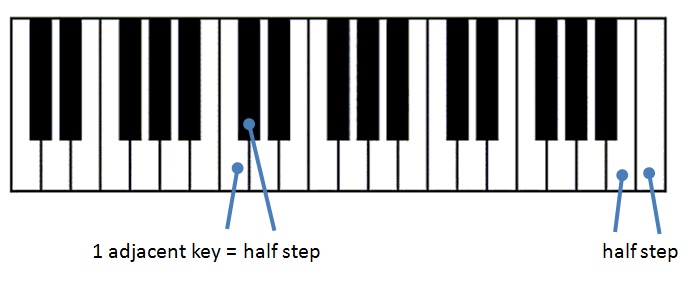
On fretted instrument, such as guitar or bass, a “half step” would be the distance of 1 fret.
A “whole step” is the distance of two half-steps. On a piano this would be the distance of three adjacent keys (two 1/2 steps), such as C to D, or Ab to Bb. On guitar/bass this would be the distance of 2 frets.
Now that we have these basic units of whole step and half step defined, we can use them to describe musical “distances between notes”.
Octave and Unison
In western music (i.e. music that had it’s origins in Western Europe) an octave is divided up into 12 half steps. If you start at any key on the piano, and go up to the next adjacent key (a 1/2 step), and continue in this way 12 more times you will end up on the same note in the next register. We call this distance of 12 half-steps an “octave”. The staring note and ending note are the same note (for example “C”) but they are said to be one octave apart.
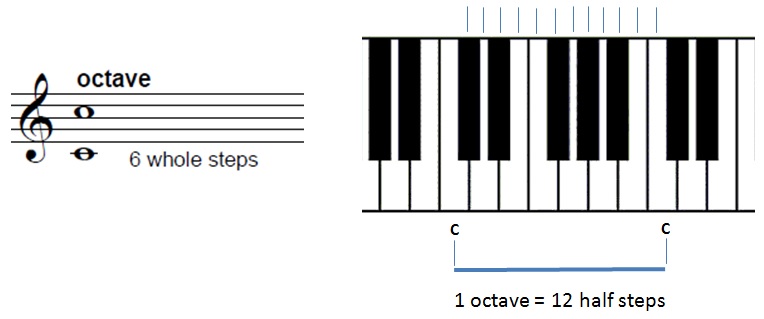 The term “octave” is used to describe notes of the same musical pitch but in different registers. It’s easy to visually see the interval of an octave on the piano.
The term “octave” is used to describe notes of the same musical pitch but in different registers. It’s easy to visually see the interval of an octave on the piano.
On guitar, the octave can be played in a few different ways. Here are a few different fingerings for doing octaves on guitar using the 1st and 4th finger, or 1st and 3rd fingers.

How are octaves used for in music?
Octaves are used extensively in music to add richness to the sound of a melody or single note. For example, if you pluck the strings of a 12-string guitar, the lower strings are tuned in octaves so that one note makes the sound of two stings together (tuned an octave apart). This is what gives a 12-string guitar such a big sound when you strum it or play a melody line on it. Wes Montgomery was a famous Jazz guitarist who popularized a style of playing solo guitar lines in octaves (see the octave fingerings above), using his thumb to strike both notes together (an octave apart). This helped to add a richness to his melody lines as he played them on guitar.
How are unisons used in music?
The word “unison” is used to describe the interval of two instruments playing exactly the same pitch (not an octave apart, but the exact same note within the same octave). Unisons are often used in music to add fullness and volume to a sound, similar to the way octaves are used. If you’ve ever heard a group of bagpipers and noticed how loud and full it sounds when there are several pipers playing together, what you’re hearing is the whole band playing everything in unison. The low drone and the melody line is often played the same by all the members which creates a huge sound in unison. When recording vocals a common production technique called “doubling” involves recording a singer performing the same exact vocal part multiple times. When those multiple tracks mixed together (often the multiple tracks are panned left/right to give a wide stereo affect) the resulting sound is a much richer version of the same vocal part. This is a great example of the usefulness of a “unison” sound.
Minor 2nd
The interval of “minor second” is defined as two notes which are a 1/2 step away from each other (e.g. C and Db). This creates a tense sound.
Here is the sound of the minor 2nd interval:
The minor 2nd interval’s tense sound is often used in soundtracks for horror and thriller movies, usually played in the upper register with violins as shown in this example below:
But this interval can also have a beautiful sound as well, when used in the right context. You will find the minor 2nd interval within chord voicings that use close harmony (all of the notes of a chord in closest proximity to each other, within the same octave) such as this voicing of A minor add9 chord. 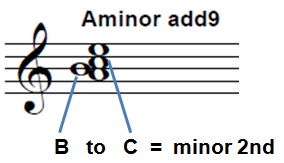
Major 2nd
The “major second” is defined as two notes which are a full step away from each other (e.g. C and D).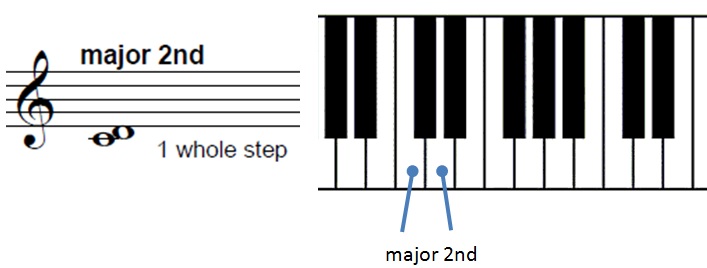 This major 2nd interval has a kind of open sound to it. .
This major 2nd interval has a kind of open sound to it. .
 You will also find the Major 2nd used in chords with close voicings, such as this A add9 chord. The major 2nd adds a kind of “wholesome” vibe. You hear this kind of use of the major 2nd in film sound tracks as well.
You will also find the Major 2nd used in chords with close voicings, such as this A add9 chord. The major 2nd adds a kind of “wholesome” vibe. You hear this kind of use of the major 2nd in film sound tracks as well.
Minor 3rd
The “minor third” is defined as two notes that are 1 & 1/2 steps away from each other (e.g. C and Eb).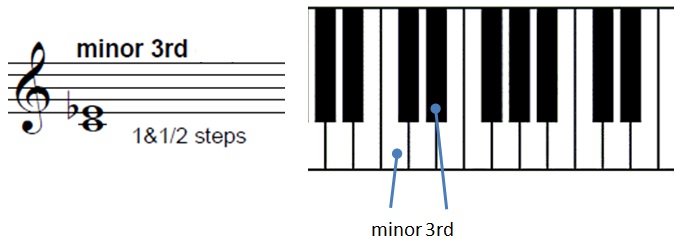 The minor 3rd makes up one of the key building blocks of triads and chords. We will be talking more about the minor 3rd as we get into a discussion on chords. Notice that the minor 3rd, has a rather “sad’ sound to it.
The minor 3rd makes up one of the key building blocks of triads and chords. We will be talking more about the minor 3rd as we get into a discussion on chords. Notice that the minor 3rd, has a rather “sad’ sound to it.
Major 3rd
The “major third” is defined as two notes that are 2 full-steps away from each other. (e.g. C and E).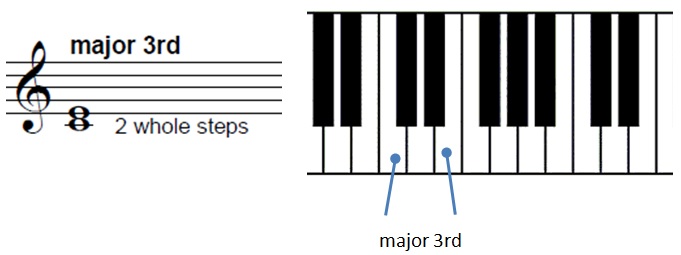 The major 3rd is also one of the sounds that is used extensively as it makes up one of the key building blocks of triads and chords. Notice, in comparison to the minor 3rd, the major 3rd has a happy sound to it.
The major 3rd is also one of the sounds that is used extensively as it makes up one of the key building blocks of triads and chords. Notice, in comparison to the minor 3rd, the major 3rd has a happy sound to it.
When chords are referred to as “Major” or “Minor”, the name comes from the interval of the 3rd within the chord (relative to the root note of the chord). Minor chords contain a minor 3rd interval, and major chords contain a major 3rd interval. I’ll be covering chords in more detail in a a upcoming articles. The minor and major 3rd intervals are one of the most common ways to harmonize melody lines in music. Here is one example of the use of major and minor thirds being used as harmony in this recognizable guitar riff from Van Morrison’s “Brown Eyed Girl”.
Perfect 4th
The perfect 4th is defined as two notes that are 2 and 1/2 steps away from each other (e.g. C and F).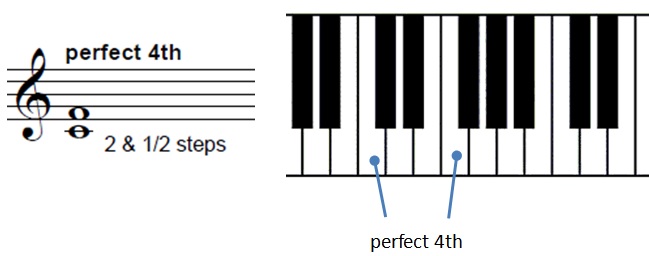
Jazz piano players often rely on chord voicings based on use of 4ths to create sophisticated open-sounding chords.
The perfect 4th interval is commonly used for certain types of guitar fills found in classic soul and R&B of the 1960s. Paul McCartney used this same kind of sound (relying on a basic melody harmonized in perfect 4ths) for the opening guitar riff for his song “Band on The Run”.
Augmented 4th
The augmented fourth (also called a diminished 5th) is defined as two notes that are 3 whole steps apart from each other.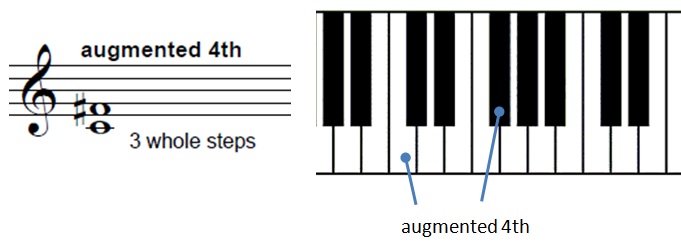 This interval is also called a tri-tone and is found within dominant 7th chords. In early music this interval was also referred to as the devil’s interval and was strictly avoided by early composers because it was thought to have such a horrible sound. However, in Jazz music especially, this interval forms the basis for some very interesting harmony and chord substitution techniques. It can also evoke a kind of odd “quirky” quality when used in the right way.
This interval is also called a tri-tone and is found within dominant 7th chords. In early music this interval was also referred to as the devil’s interval and was strictly avoided by early composers because it was thought to have such a horrible sound. However, in Jazz music especially, this interval forms the basis for some very interesting harmony and chord substitution techniques. It can also evoke a kind of odd “quirky” quality when used in the right way.
You can hear a great example of this “quirky” quality of the augmented 4th interval used extensively in the theme from The Simpsons (written by Danny Elfman).
In part II of my article I’ll be covering fifths, sixths, and sevenths. I’ll also include some useful summaries tables. Happy music making!

